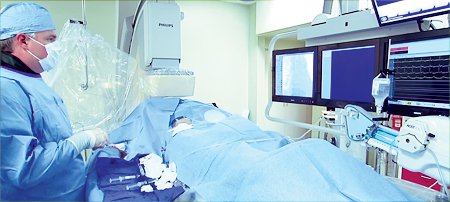Transitioning from Transfemoral to Transradial: Why the Radial Approach is Here to Stay
The transition from a transfemoral to a transradial practice can be a daunting challenge for an interventional cardiologist. This is especially true for cardiologists who have been in practice for years and have had great success with the femoral approach. The truth, however, is that radial artery catheterization is here to stay and will ultimately become the standard of care for coronary diagnostic imaging and intervention.
Reasons to Adopt Radial
Currently in the United States, there are very few centers that have greater than 50% radial penetration. Surveys of individual cardiologists indicate that physician comfort, along with lack of knowledge and training, are some of the main barriers to wider adoption. Although most acknowledge the safety of the radial approach, many still question the notion that the radial artery approach significantly reduces complications related to access. I would submit that as the radial technique evolves along with appropriate utilization of the various hemostasis bands, these safety data will be further solidified.

William H. Crowder
The other benefit of the radial approach is the improved turnaround times associated with the procedure. Less post-procedure bed rest can be a great help to already strained hospital resources. We have opened a “radial lounge” to recover our heart catheterization patients. This is an area where patients can sit in a comfortable chair, enjoy a meal or coffee, and read or watch TV while recovering from their catheterization. This frees up several more recovery beds for patients receiving more invasive procedures, and increases overall hospital productivity.

Source: William H. Crowder, MD
As safety increases and time associated with the procedure decreases, the patient experience improves. We have seen very positive feedback from our radial patients. With increased awareness, along with successful and clever marketing programs by the hospital, patients will ultimately settle for nothing less and will ask for this procedure by name.
How to Begin
The decision to start a radial program should be a team approach. I cannot emphasize enough how important having the support of the cath lab staff, hospital, manager and physician partners are in starting this endeavor. I am part of a large group practice that covers two tertiary referral centers in Jackson, Miss. The core group of interventionists within the group decided that implementing the radial approach would be an important part of our future practice. Once the decision was made, we immediately put together a plan that included input from lab staff, nurses and our industry partners. Our staff became energized, and one of our cath lab personnel even designed and had manufactured an arm support board that we use for all of our radial cases.
The next step is to schedule cases. The first few radial days should be low volume. We started with a series of three patients and blocked the whole morning for these cases. Time is needed to get familiar with the access process, sheath placement and the various catheters that are available for radial. Some start with the traditional Judkins catheters, but I would recommend starting with one of the radial-specific catheters and getting used to the idea that one catheter can engage both arteries. There are some catheters with side holes that will even enable left ventriculography to be performed. These catheters work very well, and with time, the duration of radial procedures will be shorter than with the femoral approach. The first cases are going to be frustrating, and they will take longer. Don’t let these frustrations cause setbacks. Persistence pays off.

William H. Crowder, MD, performs a procedure using the radial artery approach.
Image courtesy of William H. Crowder, MD
Early on, I had instructed the cath lab staff to set up all of my left heart caths as radial unless otherwise specified. This forced me to utilize radial. Similar to reports published this year in Circulation by Hess and colleagues, it took me about 50 cases to start to gain some of the confidence with radial I had felt with the femoral approach. After 100 cases, I came to prefer the radial approach and really started to feel that I was saving time and, most importantly, improving my patient outcomes.
Final Thoughts With our team approach and support from our hospitals, we now perform the vast majority of heart catheterizations via the radial approach. Personally, more than 90% of my catheterizations are radial. I have even branched into some peripheral work using this approach. We still have some physicians who favor femoral. Their resolve is weakening as they have recognized the success that we have experienced and observed the patient satisfaction with the radial approach. Radial is here to stay. Don’t let it pass you by.
